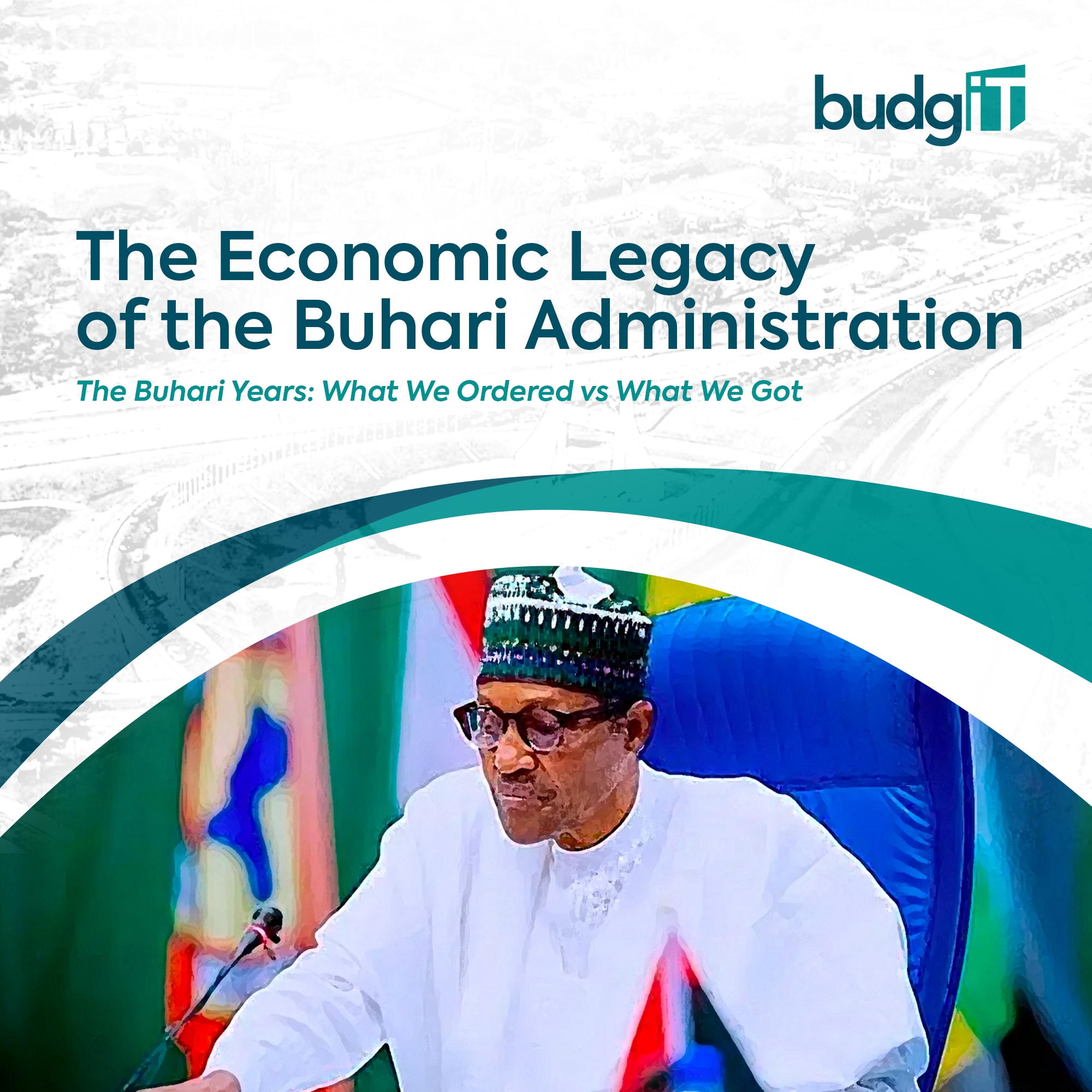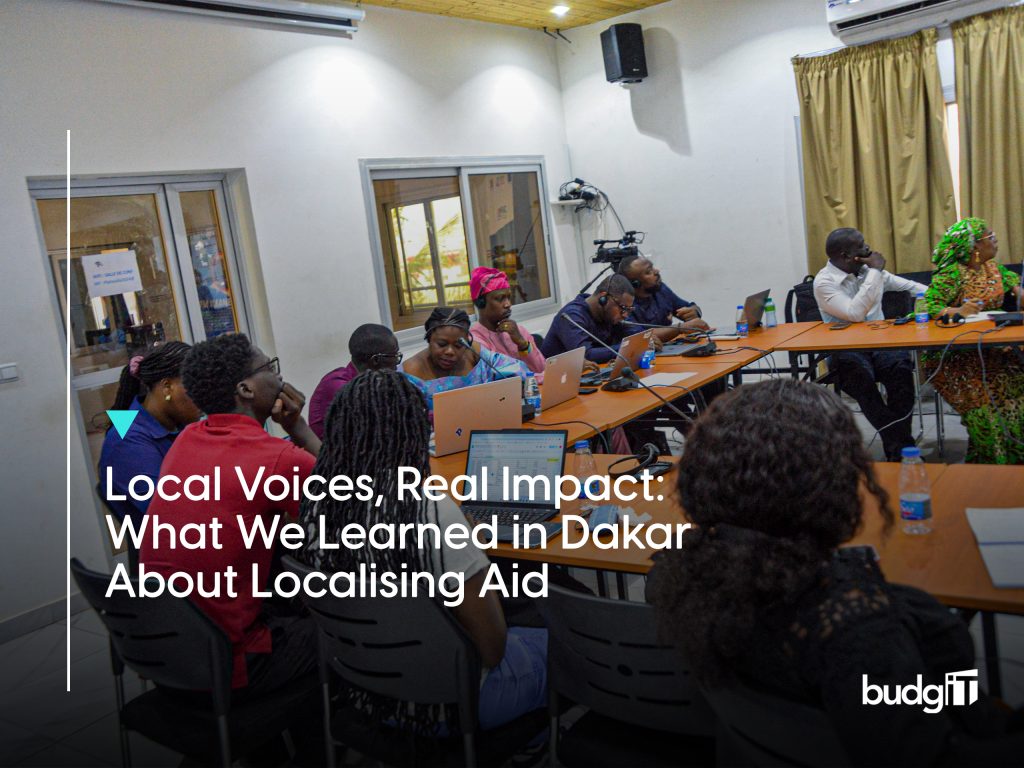The Buhari Years: What We Ordered vs What We Got – In this article, BudgIT reflects on the economic legacy of the Buhari Administration, its achievements, shortcomings, and regressive steps.
The outgoing administration of President Muhammadu Buhari will be assessed semi-chronologically, tracing the high and low points of his dual term under the following subheadings:
The Economy of the Goodluck Jonathan-Muhammadu Buhari Transition and Beyond
Brent oil prices tanked from their heights of $111 per barrel in May 2014 to $54 per barrel per day by late 2014. The currency, heavily defended with copious reserves in the Goodluck Ebele Jonathan’s administration, started to lose value, reaching 216 Naira to the US Dollar. The then Presidential candidate, Muhammadu Buhari, and his team made it a campaign slogan, showing Goodluck Jonathan’s inherent weakness in handling the economy. The exhilarating campaign, pumped with optimism, made most Nigerians believe that General Muhammadu Buhari had cut a magic wand to fix the triple threats of an infirm economy, insecurity, and galloping corruption. Unfortunately, his weak grip on governance, following his successful election and muted cabinet meant he failed to change Nigeria’s fortunes significantly.
Upon President Buhari’s takeover, growth slowed down to 2.35% in Q2 2015 (from 6.54% in Q2 2014), and oil prices sunk lower, reaching $40 per barrel in December 2015. Also, disruptions started to emerge from the Niger Delta pipeline bombings by militants that led to production shut-ins of over 600,000 barrels, creating twin challenges of price and quantity deliveries. While it was expected that the Buhari administration would rally quickly to stem the weakening economy, it did not apply urgency. The signs were evident with the late appointment of Ministers and key cabinet officials. The Jonathan administration offered a transition budget with a capital expenditure projection of N633bn (down from N1.55tn in 2014). While this was inadequate to stimulate the economy-already in a tailspin-the absence of Ministers within Buhari’s first 6 months compounded the error. By the time Ministers were appointed, the first budget had kicked in, but it would not be until May 6, 2016, that the Budget was passed. According to the Budget Office figures, in the first six months of 2016 of weak economic conditions, the Federal Government only expended N159bn on capital expenditure. By Q2 2016, while other oil economies were fairly reeling from poor macroeconomic conditions, the Buhari government’s inefficient approach to handling the economic challenges compounded the situation, and the Nigerian economy fell into recession.
A Money Dance with the States: The Federal Government as a Fiscal “Nanny”
While the Federal Government started to ramp up expenditure quickly to stem the slide in the economy, it could not look away from the challenges of states’ inability to perform their basic duties, such as paying their workers. According to BudgIT research, 33 out of 36 states were unable to meet their obligations to their workers, thereby collapsing state economies with withered industrial bases and poor private sector capacities. The Buhari government aided the states through re-calculation of Paris Club Debt deductions, done by the Federal Government in the late 2000s. In addition, the Central Bank was tasked to provide a buffer for the states, ending with a series of interventions that included N614bn to states, N700bn for Federal road refunds, $5.4bn for Paris Club, and restructuring of commercial banks loans into FG bonds worth N575bn. This led to opening of the vaults as the Federal Government continued to either spend or guarantee monies it didn’t have. The Federal Government was not immune from the liquidity crunch with its propensity to spend to gear the economy. This opened up a vista of “Ways and Means” that has piled up to over N25tn as of 2023.
Despite Moving to Recovery the Unexpected Happened
The Federal Government also launched the Economic Recovery and Growth Plan (ERGP), a high-spending plan that was meant to catalyze the economy to full recovery—which happened in late 2017 (reaching $75 per barrel) with stable oil prices and production. The continuous spending also saw capital expenditures from the government rise from N1.44tn (2017) to N1.66tn (2018) and N1.17tn (2019), which meant that fiscal efforts were also increasing money in circulation at a frenetic pace. As cash injection expanded, inflation started to whip up, considering that the “Ways and Means” (which should have been emergency support in a period of recession) became a staple of the Federal Government. The National Assembly which was meant to be the stopgap, became reticent in the face of fiscal illegality. Through the years, the Buhari administration struggled to raise revenues to match its spending appetite.
When the economy started to recover, COVID-19 struck in early 2020, collapsing global economies to which Nigeria was not immune. With the lag in demand coupled with a slip in oil prices, Nigeria entered another round of economic recession with negative growth of -3.62% in Q3 2020. The Federal Government offered a N500bn economic stimulus program with the Central Bank providing targeted support rising to over N150bn.
The Buhari Years: High Debt, High Inflation and Low Growth
According to the Budget Office, between 2016 and 2022, the Buhari government raised total revenues of N26.67tn and expended N60.64tn, leaving a deficit of N33.97tn. The gaping hole was financed with FG domestic debt, which rose from N8.84tn as of December 2015 to N44.91tn as of June 2023, while external debt rose from $7.35bn in December 2015 to $37.2bn in June 2023. This excludes support provided by the Central Bank amounting to N25tn. Ultimately, President Buhari moved Nigeria’s debt profile from N42tn to N77tn. This has had attendant effects on debt servicing, which rose from N1.06tn in 2015 to N5.24tn as of 2022. In fact, under President Buhari’s administration, the debt-service-to-revenue ratio grew from 29% to 96%.
During the administration of President Buhari, the Central Bank extended beyond its monetary policy remit, having a firm grip on fiscal policy with its outsized role. In fact, CBN policies increased the money supply from N18tn in 2015 to N55tn in 2023. While it provided unrestrained liquidity to the Federal Government, the apex bank abandoned its primary mandate of price stability. It continued to apply blunt tools by raising the Monetary Policy Rate from 12.5% in 2015 to 18% in April 2023. This did not taper the inflation rate, which has risen to 22.5%, while food inflation galloped to 24% as of April 2023. Food inflation has continued to rise despite over N800bn spent by the Central Bank on the Anchor Borrowers’ Program, which has been touted to have repayment challenges. Unemployment rose from 10.4% in 2015 to 33.4% in 2020 under President Buhari’s watch as the clumsy exchange rate management—with a wide difference between the official and parallel market rates—made it difficult for businesses to thrive. Buhari also prevaricated on the subsidy removal, which his administration spent at least N10tn to service. While Buhari’s government planned to have the subsidy removed as the price of crude rose; it failed to act and continued a wasteful venture that only required firm commitment to implement.
While his administration wound up, it had the chance to seize another round of oil windfall with skyrocketing oil prices reaching $114 per barrel (April 2022) but with little incentive to do so, as CBN “printing presses” continued to flood the system with liquidity. Nigeria’s oil production slipped below one million barrels per day at a time when oil economies skyrocketed to an unprecedented fortune. The attendant effect is that the non-oil share of public revenues grew rapidly from 44.6% in 2015 to 59.4% in 2022. However, Nigeria’s spending was untargeted as several BudgIT analyses continued to show that the Nigerian budget performing below par, with agencies spending public funds without the mandate to do so, foreclosing any chances of fiscal consolidation.
Legislation, Policy and Infrastructure: Wins or Goalless Draws?
The Buhari administration would look at the Warri-Itakpe, Abuja Light, Abuja-Kaduna, Lagos-Ibadan rail projects, and the Kaduna-Kano, Lagos-Ibadan, Enugu-Port Harcourt, Bodo-Bonny, Apapa-Oshodi-Oworonshoki-Ojota road projects as testaments to his huge spending. He would also take pride in the Ajaokuta-Kano-Kaduna rail line: an important act to bring gas to the industrial heartland of Northern Nigeria. However, Buhari’s administration did not change the quality of life, which has sunk with rising inflation and weakened exchange rates. This is despite spending over N1tn on social spending, warehoused inside a new Ministry, and leaving behind a grim picture of the 133 million Nigerians now in multidimensional poverty.
President Buhari would be recognized for the Petroleum Industry Act (a half-hearted, though welcome effort that pushes the hydrocarbon sector ahead) and the Road Tax Credit Scheme, which have helped in warehousing revenues for specific projects (but is subject to abuse with recent indiscriminate allocation). Other schemes, such as the Sukuk bonds, have also helped accelerate certain infrastructure growth. The spending bills will include the New Terminals for International Airports in Lagos, Abuja, Kano, and Port Harcourt, and the $2bn Siemens Power Program, whose fruits Nigerians still await to bloom. Buhari’s administration will also be credited with negotiating the outstanding Joint Venture Cash Calls, through an arrangement that allowed oil majors to drill extra barrels to defray their costs.
The spending pile-up included energizing programs in schools and policy reforms, such as the National Collateral Registry Act, Nigerian Startup Act, and so on. Certain decisions, such as expending $1bn on Port Harcourt Petroleum Refinery, reiterate the statist bent of the Buhari government. The Buhari leadership also enhanced the use of Development Banking, with the Bank of Industry giving out loans in trillions. The newly minted Development Banks also claimed to have advanced over N400bn to emerging banks. The administration of President Buhari signed the NLNG Train 7 into action. It also ramped up spending on security, retooling the Nigerian Air Force and Nigerian Navy; including the famous acquisition of Super Tucano aircraft. It is to his credit that the late approval was made for the state to transmit and distribute power and also to invest in the railway, moving Nigeria forward in the argument for restructuring.
Conclusion
In the end, President Buhari leaves a legacy of debt which almost doubled from 18% to 35% of GDP. He leaves inflation at 22.4%, with 133 million Nigerians in poverty and a raft of economic policies and spending that accelerated a significant level of infrastructure. However, the failed attempt to execute the currency redesign in time exacerbated the crisis in his final days, showing that while it spent more resources, its incoherent efforts still reek of not doing enough to lift the standard of living for the everyday Nigerian. In fact, the value of Nigerians’ savings eroded and their quality of life diminished, underscoring the fact that irrespective of the need to spend, sustainable growth requires a solid macroeconomic framework. This is a mission that President Buhari and the institutions he spearheaded, failed woefully at.



